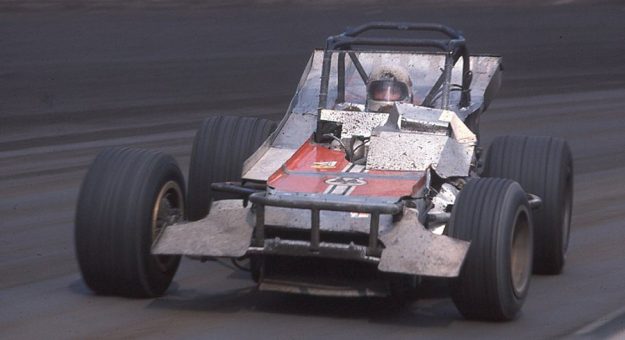It’s approximately 35 miles from the central New York metropolis of Syracuse to the Lake Ontario port city of Oswego, two places that had starkly different heritages, and definitions, when it came to open-cockpit auto racing.
The New York State Fairgrounds in Syracuse was a one-mile dirt track and had been hosting championship-type race cars since the dawn of American motorsports. Oswego Speedway was a five-eighths-mile asphalt track.
In 1978, Oswego’s weekly cars had evolved into highly specialized, radically offset missiles on asphalt that had already punched more than one driver’s ticket to race at Indianapolis Motor Speedway.
Conceptually, and stylistically, sprint cars and supermodifieds in the late 1970s were as separate as chalk and cheese. And yet a couple of guys with marked success in Northeast auto racing thought they belonged together on a scary-fast, unforgiving track that, in 1978, was neutral ground for both classes.
Just twice — on the same day — the supers from Oswego faced sprint cars as rules-tweaked equals on the Moody Mile. The results were spectacular, terrifying and produced an overall winner who was unexpected.
“Those were the two short-track feature classes, supermodifieds for blacktop and World of Outlaws sprint cars for dirt,” said Glenn Donnelly, who promoted Syracuse and brainstormed Super DIRT Week. “I was pitting the two of them together. And who ended up winning at Syracuse? A supermodified driven by a guy who raced at Indy.”
Sprint cars had been part of Donnelly’s October extravaganza since 1975, when United Racing Club champion Garry Gollub, using a 312-cubic-inch engine and a small wing, bested a field that included Jimmy Boyd, who later won the first World of Outlaws event.
That same night, Oswego ran a Syracuse tribute race for supers, captured by Michigan invader Johnny Logan.
USAC Champ cars joined Super DIRT Week, as it was now known, in 1976, when Bentley Warren was invited in for an exhibition run and bumped the Syracuse track record to 112 mph in his supermodified. The sprint cars returned in 1977, Kenny Weld copping the win with Pennsylvania-legal big-block power. Paul Pitzer drove a big-block Bob Weikert car to victory in the next Syracuse show for sprint cars during the summer of 1977.
During this time, Syracuse and Oswego had a working relationship.
“Glenn basically was starting this outlaw deal on the mile, and in the initial days, it was non-winged,” said Dick O’Brien, the longtime Oswego promoter. “We were drawing well at Oswego, and the surface at Syracuse was hard, black and slick, just like pavement. We, both of us, figured that our cars would bring a lot of fans down from Oswego. There weren’t that many sprint cars in central New York at the time.
“Glenn’s show was always in October, so we always combined it, cooperatively, to have an event that night at Oswego after the mile. I had a deal to bring buses to Syracuse and for $20, they’d take you to Oswego and then bring you back to the campground at the fairgrounds at Syracuse. One time, we had 22 buses, so there were pluses both ways.”
In 1978, the new Syracuse Super Nationals ran under World of Outlaws sanction, although most of the traveling stars were chasing points in California when October rolled around. To equalize competition, wings were banned for both classes. Fifty-two cars signed in, a dozen from Oswego.
Conspicuously absent was Oswego kingpin Jim Shampine, whose radical, offset supermodified won 11 straight Oswego features in 1978. The qualifiers faced off in dual 32-lap features.
In the first, Randy Wolfe snagged Pitzer’s dropped driveshaft and tumbled most of the way down the backstretch. Warren took the win over fellow Oswego regular Bob Stetler and Keystone stalwarts Allen Klinger, Smokey Snellbaker and Gollub.
Click below to continue reading.
